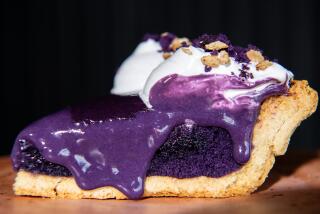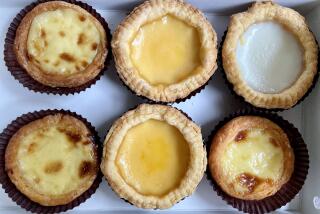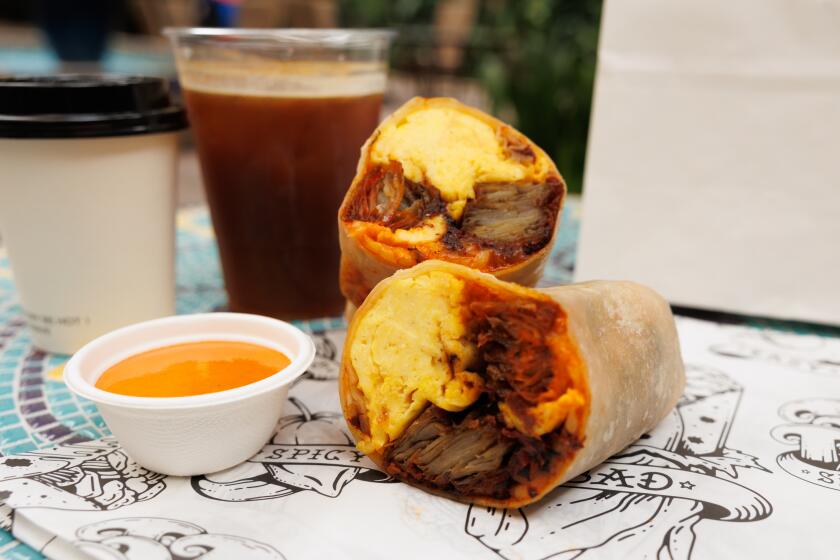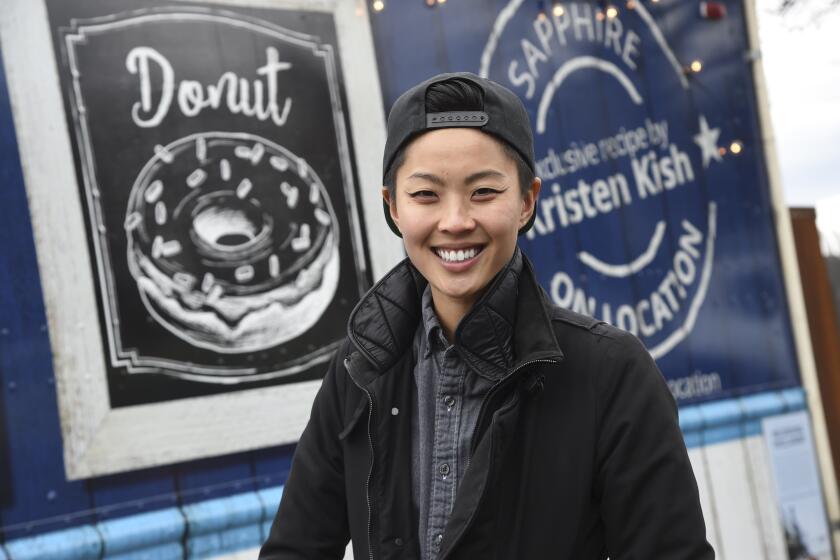Pop-Tarts any way you want them
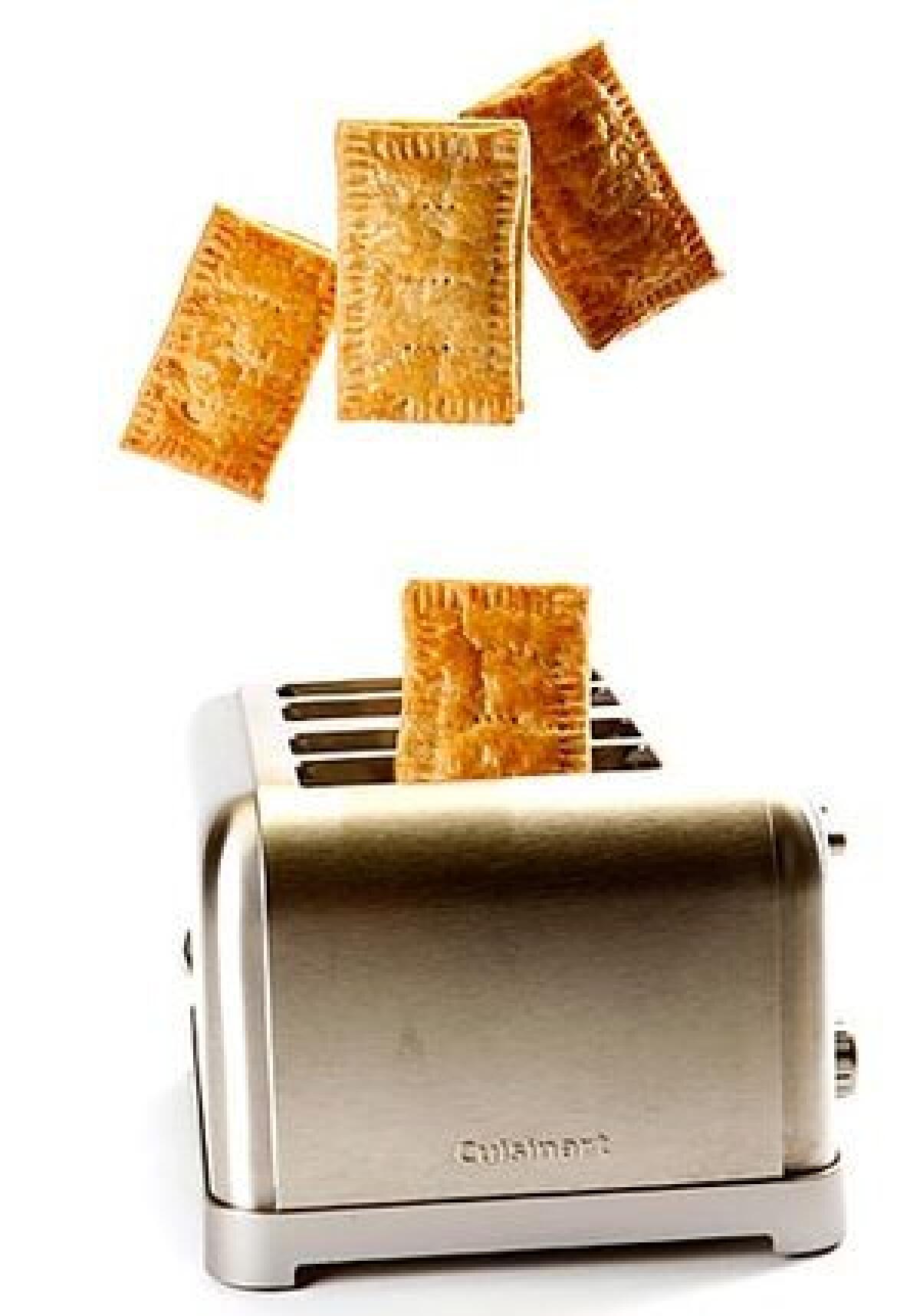
- Share via
Almost half a century ago, in an epiphanic moment of marketing genius, Kellogg’s is credited with inventing the Pop-Tart. Your very own individually wrapped piece of pie. In a toaster.
Since that happy occasion, the Pop-Tart has become a part, literally, of the pop culture landscape: Milton the talking toaster, if you watched commercials in the ‘70s, or more recently last year’s Times Square Pop-Tart pop-up shop. Devotees of the Pop-Tart may also remember an old Dave Barry story, in which the humorist set a strawberry Pop-Tart on fire in his toaster, just to prove he could.
But commercial Pop-Tarts have their limitations, bouts of nostalgia and flame-throwing toasters notwithstanding, and we’re not just talking about the trademarked name and all those foil wrappers. A frosted strawberry Pop-Tart has 38 ingredients, not including parentheticals. If you want a real piece of pie in your own toaster and a moment of true pastry epiphany, try making your own launchable tarts. It is, and you should have expected this, as easy as pie.
If you’ve grown up eating the kind that pops out of a cardboard box, homemade tarts are revelatory, in the same way that a good pie is a revelation when it comes out of the oven. Flaky crust encasing a jammy center — you can fill them with almost anything — and popped in the toaster just long enough to warm the tart, give a sudden crisp to the edges and encourage a bit of steam when you break it open. Such a homemade tart, palm-sized, the crust built with butter and a sifting of whole wheat, the filling a spoonful of fruit compote or chocolate or even almond paste, bears as much relation to junk food as does, well, your grandmother’s pie.
Constructing a tiny pie for your toaster is hardly a new idea. In the decades since these little tarts have filled your kids’ lunchboxes, pastry chefs have orchestrated their own versions. Fred Eric has made them at Fred 62, his Silver Lake retro eatery, for the last 12 years. For both legal and personal reasons, he calls them Punk Tarts, and Eric has filled them with grape jam, with bananas and caramel and chocolate, with pumpkin for the holidays. “We had toasters on the tables,” recalls Eric, “but the fire department took them away.”
Longtime Spago pastry chef Sherry Yard first experimented with the tarts long before she arrived in Los Angeles, at San Francisco’s Campton Place Hotel, where she made tarts with gingerbread dough. “We couldn’t afford a plater, but we had a toaster,” says Yard. As recently as this year, she gave serious thought to serving them at the Oscars, even contemplating how to wheel toasters in and pop them tableside, as one would flambé a dessert.
These days you can find the individual tarts on the roving pastry plate at downtown’s Nickel Diner, frosted pink and dusted with sprinkles. Cake Monkey’s “pop pies” are on the menu at Umami Burger and Gelato Bar and Jones Coffee Roaster. And amid the beautiful world of glass and patisserie at Joan’s on Third, you will find perfectly crimped tarts, filled with Nutella or perhaps cinnamon-sugar, if you get to the shop before they sell out.
They’re popping up in cookbooks and food blogs as well: A recent search found recipes for the homemade tarts amid the pages of Joanne Chang’s newly published “Flour,” on King Arthur Flour’s baking blog and on the popular food blogs Chez Pim and Smitten Kitchen — a testament to the Proustian relevance of the commercial Pop-Tart. Or maybe to the fact that it’s hard not to love a pie the size and shape of an iPhone.
Making your own tarts at home is a question of basic components. You need good pie dough and a filling of your choice. Beyond that, there are the bells and whistles — frosting, sugar sprinkles — but those are optional, and often superfluous. If you have high-quality ingredients and good pastry, loading your tarts can overload the flavors and textures. Not to mention the question of the frosting melting into your toaster.
Although both the original Kellogg’s Pop-Tarts and some very good patisserie tarts use more of a shortbread dough than a traditional pâte brisée, there’s a lot to be said for the incomparably lovely architecture of a good flaky pie crust. You can use any pie crust recipe: your own personal favorite, that of your preferred pastry chef or baking book author, or your grandmother’s. You could even, in a pinch, use purchased dough.
Or you can use this one, which is a pretty basic pie dough, made with butter, rather than shortening or lard or a combination. And yes, if Grandma used Crisco or leaf lard, by all means use her recipe. This recipe adds an egg yolk to the mix to give the dough a bit more structure — it is going into the toaster, after all — and sifts in some whole wheat flour with the all-purpose for a bit more flavor.
Once you make the dough, simply roll it out, add spoonfuls of filling and top it with a second piece of dough. Use a ruler to straighten and true up the edges, to divide up the dough into corresponding rectangles and to brush the bottom layer of dough with an egg wash to help seal the pieces together. Imagine that you’re making ravioli: The trick is simply to make sure that the filling is properly encased. Then crimp the sides with the tines of a fork, prick the tops of the tarts so that steam can escape, freeze them briefly — this relaxes the gluten in the flour and keeps the butter intact — brush them with the rest of the egg wash and bake them.
As for the filling, you can re-create your childhood favorites with a spoonful of strawberry jam, a mixture of brown sugar and butter or sauteed apples (the original Kellogg’s flavors). Or you can go a bit upscale, making a chocolate ganache or filling your tart with frangipane, a classic French almond paste mixture that will produce tarts that bear a happy resemblance to almond croissants. Nutella, predictably, makes a glorious filling, as does any good-quality jam or compote. Or try mixing peanut butter and jelly, or using another nut butter for a morning tart that actually makes a good breakfast.
Whatever you fill your tart with, just be sure to seal it tightly. Press the pieces of dough firmly together and crimp the sides. The last thing you want is a free-form pastry spilling across your baking sheet. If you like, you can even make smaller tarts by dividing the rectangles in half again. And then there are the rah-rahs, which, particularly if you are using a toaster oven instead of an old-fashioned vertical toaster, can be fun too. A drizzle of icing. A dusting of raw sugar. Your kid’s birthday cake decorations.
Wrap your homemade tarts in foil and have them for lunch with a carton of milk, or serve them on china alongside a demitasse of espresso. Either way, they will bear enough resemblance to the ones that have popped out of the box for the last 46 years to give you a moment of déjà vu — yet one brought to you by a creditable pastry chef. Consider it your grandmother’s pop culture moment.
More to Read
Eat your way across L.A.
Get our weekly Tasting Notes newsletter for reviews, news and more.
You may occasionally receive promotional content from the Los Angeles Times.

